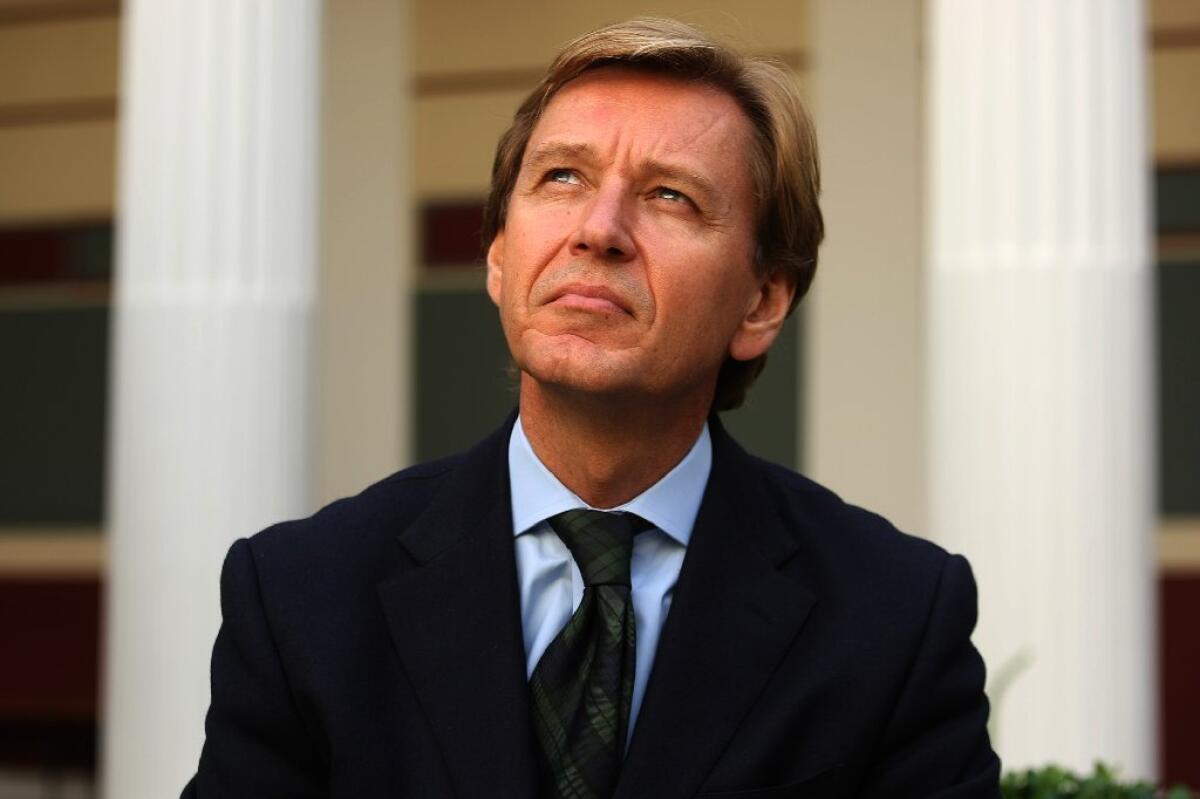Getty’s Potts: Richest museum can’t outbid far richer collectors

- Share via
Nowadays, not even the J. Paul Getty Trust, the world’s richest art institution, can afford to outbid the ultra-rich when they’ve set their hearts and wallets on a masterpiece, according to one of the Getty’s key figures in that competition.
“There are deep-pocketed New York hedge fund managers who usually get what they want,” Timothy Potts, director of the Getty Museum, said during a conversation Tuesday with Los Angeles Times arts reporters and editors.
Not to mention oil moguls -- today’s even richer versions of J. Paul Getty, the petroleum tycoon whose 1976 bequest of $2.9 billion in his oil company’s stock (in 2014 dollars) established the Los Angeles art trust that carries his name.
Potts noted reports that an 1892 painting by Paul Gauguin had sold last week for $300 million in a private transaction between a Swiss owner and a buyer who’s said to be from the Persian Gulf kingdom of Qatar.
That is several orders of magnitude beyond the $65.1 million the Getty spent at auction three months ago to buy “Spring (Le Printemps),” Edouard Manet’s 1881 painting of a young woman with an umbrella.
The $300-million Gauguin, “Nafea Faa Ipoipo (When Will You Marry)?” might have made a welcome counterpoint to the Getty’s own 1892 Gaugin, “Arii Matamoe (the Royal End).” Bought from a different Swiss owner in 2008 for an undisclosed price, it shows the severed head of a deposed Tahitian king.
If the reported price is correct, the record-setting Gaugin cost more than the Getty Trust’s entire recent annual operating budgets of about $280 million. That includes not just the Getty Museum and Getty Villa, but a grant-making foundation and separate institutes for art research and worldwide art conservation projects.
Given the unprecedented gap between private wealth and even the richest nonprofit cultural institutions, Potts acknowledged that the Getty no longer can count strictly on purchases to make important improvements to its collection. The Getty focuses on Greek and Roman antiquities, European paintings, French furnishings and decorative arts, drawings, photography and medieval illuminated manuscripts.
Consequently, Potts said he’s doing what most every other museum director does to build a collection -- making the soft-sell courtship of private collectors part of his daily work routine, in hopes they can be persuaded, sooner or later, to give the Getty some highly desirable pieces, or even entire collections.
But will prospective art donors want to give things to an institution that’s long been perceived as the Croesus of the museum world?
Conventional wisdom says they won’t, Potts acknowledged. “but I’m not at all persuaded conventional wisdom is correct on this.”
He outlined the Getty’s case:
The Getty is uniquely positioned, Potts said, to provide all the best accouterments for a collector’s cherished things:
--two museum settings where admission is free and combined attendance grew last year to a record of just under 1.8 million.
--an endowment that ensures institutional stability.
--money for conservation that will keep donated works in mint condition.
--reliable funding for scholarly research that might generate new insights into the donated work.
“No collection would be more thoroughly researched, conserved and made special” than a collection gifted to the Getty, Potts said.
To date, the Getty’s main art acquisitions via donation have been a collection of 28 20th century outdoor sculptures bequeathed in 2005 by film producer Ray Stark and his wife Fran, and about 2,000 photographs by Robert Mapplethorpe that came through a combination purchase and donation from the Robert Mapplethorpe Foundation in 2011. The Getty shares ownership of the photos with the Los Angeles County Museum of Art.
Positioning the Getty as a recipient for art philanthropy is “a long-range process” that may require years to bear fruit, said Potts, a native Australian who became museum director in September 2012.
“Almost every day a bit of the day is having a phone call or responding to an email with someone who’s a collector,” he said. “It’s developing a relationship.”
Potts spent 18 years leading museums on three continents -- the National Gallery of Victoria in Melbourne; the Kimbell Art Museum in Fort Worth; and the Fitzwilliam Museum at the University of Cambridge in Britain -- before coming to the Getty.
One thing that’s impressed him in L.A., he said, is how each major museum “has a distinctive character. They’re individual and interesting institutions.”
One thing that’s bothered him is the perception that the Getty is “elitist.”
“If that’s [the perception] then we must be the most misunderstood institution on the planet,” Potts said. “Everything we do is put out there to enjoy [for free]. No financial barriers -- just enjoy.”
Follow @boehmm for arts news and features
More to Read
The biggest entertainment stories
Get our big stories about Hollywood, film, television, music, arts, culture and more right in your inbox as soon as they publish.
You may occasionally receive promotional content from the Los Angeles Times.











